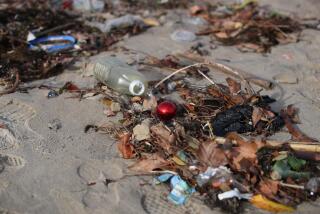EARTHWATCH : Safer Bug Traps : The son also rises as an environment-conscious boy teaches adults about natural pest control.
- Share via
The other day our friend Randee came over to show off her new baby. After the requisite oohing and aahing, we asked her how she was doing. She burst into tears. We assumed it was a postpartum mood swing, but we were astounded to discover that the cause of her outburst was not sleep deprivation or feeding woes. It was fleas.
Seems she’d bought her older child a puppy, an irresistible ball of fluff who, it turned out, had an equally irresistible flea population.
My initial reaction was, why the tears? Just call an exterminator, or buy some of those flea bombs and zap everything in sight. But before I even opened my mouth I realized what a bad idea that was. We’re all too environmentally aware these days to calmly accept the idea of bombarding the air with DDT and the like. As Randee was quick to point out, even the tiniest amounts of toxic bug killers are a threat to a newborn baby.
What to do? My 12-year-old son provided the answer. He’s a junior entomologist, with a room full of forbidding-looking specimens in jars and display cases. He had read in a bug club bulletin about a natural way to get rid of fleas and proceeded to demonstrate.
First, he set out a shallow pan, like a baking pan, and filled it with water to which he added some liquid soap. Next to it he placed a goose-necked lamp, arranged so the light shone into the water. He explained that fleas are attracted by heat and light, and they can’t swim when the surface tension of the water is broken by soap.
By leaving his contraption in the middle of a flea-infested room at night, the bugs are attracted by the lamp, causing them to jump into the water and drown.
Well, we were skeptical, but Randee was desperate, so she tried it. The next day, she called up to report that her first attempt resulted in a container full of dead fleas. By repeating the experiment for a week, she got the flea problem under control--without having to bail out of the house.
Meanwhile, another bug crisis broke out, this time in our kitchen, where someone (accusing fingers were pointed, but no guilty party was found) let a half-eaten peach rot behind the stove. By the time the offending peach had been found, the kitchen was full off fruit flies.
Again my son came to the rescue, this time with a two-quart plastic soda bottle (the kind that looks as if a green or black bowl has been glued to the bottom) and a bread knife. He energetically sawed the bottle through the middle. When he was done, he poured some honey-water into the bottom half (he said any sweet liquid would do) and stuck the inverted top half, spout pointing downward , into the bottom half.
This, he announced, was a fly trap. Sure enough, the next morning the thing was full of fruit flies. They had gone down the spout to get at the honey-water, and then couldn’t figure out how to get out again.
This set me to thinking. Without resorting to the disgusting rolls of flypaper that used to hang from people’s ceilings when I was a kid, I figured there must be other ways to kill bugs without causing indoor pollution.
Well, there are. Locally, feed stores, pet stores and some health food stores carry safer flea- and pest-control products for pets.
Traditional flea collars are problematic, it turns out. They emit a gas that, when overused, can damage your pet’s nervous system. And we throw away 50 million annually, posing a long-term pollution risk to soil and water. Some hardware stores offer electric gizmos that zap bugs or repel them electronically. But the proud parent in me somehow prefers my son’s Rube Goldberg bug machines. His bug club bulletin cited successful lab tests, but had no data on home use.
All we know is it worked for us.
Last week’s bad news about the ozone layer (more damaged than we thought) indicted cleaning solutions along with the usual CFCs. And we already know about pesticides in the food supply. Our obsession with “powerful” products for banishing dirt and bugs now ironically threatens to louse up the air and land.
My son’s “brain intensive” bug killers--using knowledge rather than nukes--are, I hope, an example of a good new trend. Randee thinks so. She’s an author, and she’s now at work on a children’s book: “Eco-Commando.”
* THE DETAILS: Ventura Bookstore, (805) 643-4069, carries “Nontoxic and Natural: How to Avoid Dangerous Everyday Products and Buy or Make Safe Ones” by Debra Dadd. The Wharf, (805) 648-5035, carries a wide range of safer products, and the staff is knowledgeable. For a series of pamphlets, “The Least Toxic Pest Management Series,” that provides information and recommendations on this topic, send $1 to The Bio-Integral Resource Center, a private nonprofit organization, at P.O. Box 7414, Berkeley 94707.
More to Read
Sign up for Essential California
The most important California stories and recommendations in your inbox every morning.
You may occasionally receive promotional content from the Los Angeles Times.










